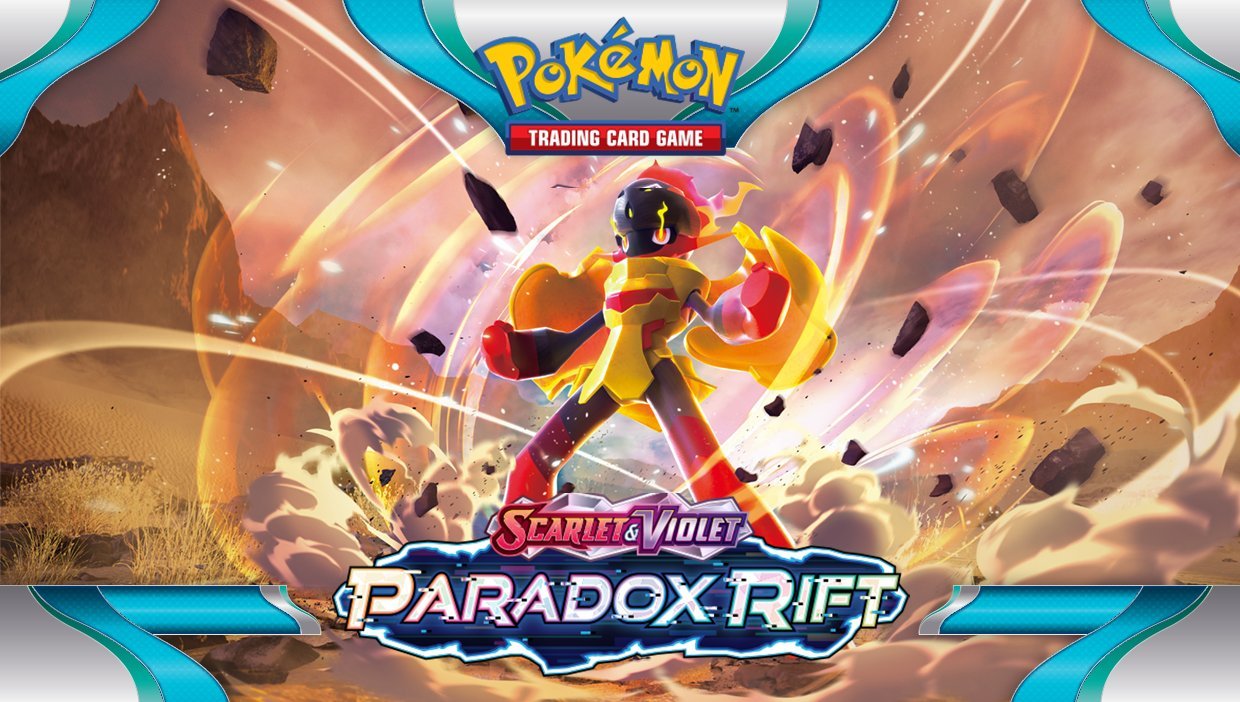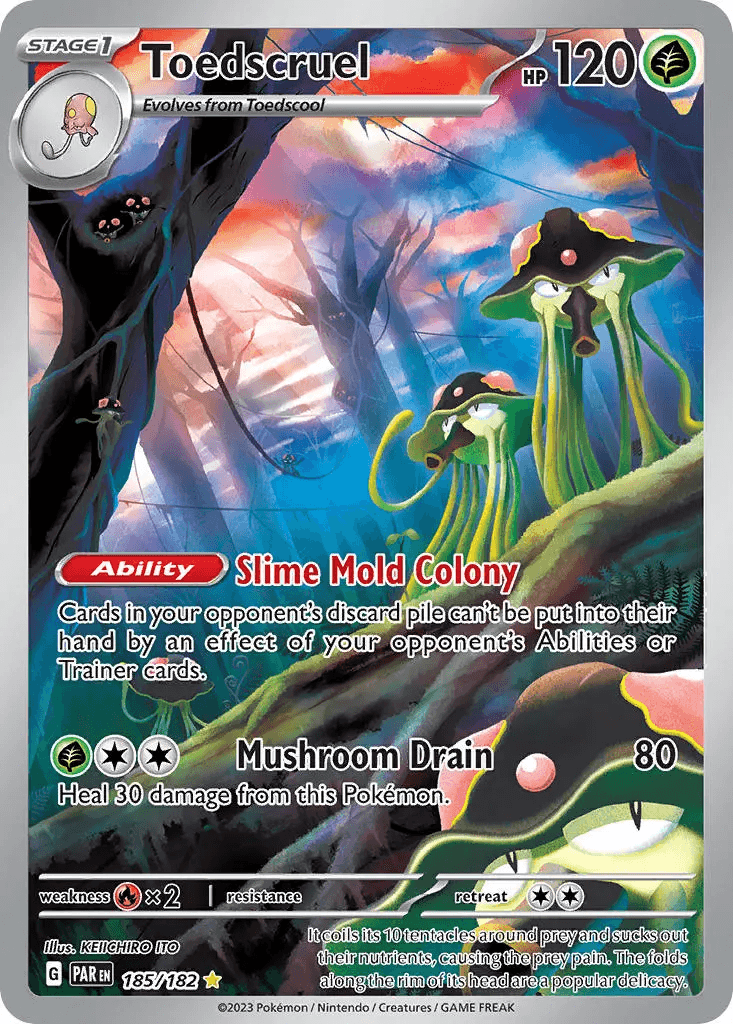Paradox Rift Set Review
After two relatively tame sets in Obsidian Flames and 151, the new Paradox Rift set promises to be wild and unpredictable. This set is interesting for a multitude of reasons, including the introduction of Ancient and Future Pokémon, as well as opening up for prerelease before releasing to Japanese audiences. With these new cards will surely come huge changes for Gym Leader Challenge as well, so don’t miss out!
Toedscruel
One of the biggest challenges in GLC is managing your resources in a deck with no duplicate copies of any card. To increase consistency and apply continuous pressure, many decks will recover cards from their discard pile in some way, often with Trainers like Klara or support Pokémon like Starmie. But what if these abilities just didn’t work? Toesdcruel is a great hate card for your opponent’s recursive strategies that might seek to reuse cards that go to the discard pile. Although Grass deck are often very fast and aggressive in GLC, maybe Toesdcruel has a place to stop your opponent from recovering from your beatdown!
Chi-Yu
Most trainers would agree that Fire is one of the weaker types in GLC, and most Fire trainers would agree that this is largely due to a lack of efficient Basic attackers in the type. Here, the card designers tease us with a new Basic Fire-type Pokémon which may be better than any existing options but probably won’t propel the type to new heights. Chi-Yu boasts decent stats with 110 HP and a Retreat Cost of 1, great for an early-game Pokémon that wants to set up some energy with its first attack then get out of there. If your opponent isn’t careful, they’ll be on the receiving end of Chi-Yu’s Megafire of Envy attack later in the game, which does a massive amount of damage for just 2 energy. While this cute, fishy fellow might not rescue Fire from its lackluster position in the metagame, it’ll certainly be a welcome addition to any Fire deck looking to improve its tempo in the early or late game.
Veluza
As mentioned above with Toedscruel, an important aspect of Gym Leader Challenge is managing your resources. Some decks do this by recovering those resources throughout the game, such as Hydro Pump decks that need to keep bringing their energy back to power up their attackers. While there are cards that can put energy back into your hand or your deck, why not just keep them on board? Veluza is a big Basic Pokémon that would be a great target for Water energy acceleration by the likes of Blastoise or Baxcalibur in the early game. When knocked out, Veluza saves you from having to find a few energy to power up your next attacker, smoothing out awkward turns and keeping your powerful deck churning.
Elekid
It’s not often that a Pokémon comes around with just 30 HP. The recent wave of “Baby Pokémon” have all shared this low HP and a free attack. These Pokémon can be knocked out by a stiff breeze, which can deter many players from using them. But if you’re brave enough, Elekid may reward you by sneaking some prizes out of nowhere. 30 damage for 0 energy is an amazing rate for an attack, great for setting up a KO or picking your opponent’s weakened Pokémon off the bench. And to top it off, Elekid has no Retreat Cost, meaning that it can run away to the bench next turn should it manage to survive. Sometimes GLC isn’t about being the biggest and strongest; it’s about being the smallest and fastest!
Xatu
Those who have played Standard format may recognize Xatu’s Clairvoyant Sense — it’s nearly the same as Shadow Rider Calyrex’s Underworld Door ability; the powerful combination of energy acceleration and draw power. Now Psychic trainers have access to this ability in GLC, and on a Pokémon that only gives up a single prize as well. Xatu is just one of several acceleration options that Psychic decks now have access to (see also: Malamar and Gardevoir), and one of several consistency Pokémon (see also: Gallade and Tinkaton). While some types are challenged with trying to make a deck work with too few support options, Psychic trainers will have difficulty choosing which of these many options are best for their deck!
Espathra
This set has not one but two freaky, Psychic birds that may see play in GLC. Espathra has the Stance Ability, which is functionally identical to Garchomp’s Sonic Slip Ability. This Ability can be a huge tempo swing, giving you a big hit into the opponent and demanding they knock out one of your benched Pokémon next turn if they want to return the favor. Espathra’s attack isn’t too bad either, taking KOs with ease if you’ve discarded Tulip. Plus, if your opponents seem set on devolving your Pokémon, Espathra is a great recursive threat to continue evolving and messing with your opponent’s tempo.
Groudon
The Continent Pokémon is known to lay the beatdown with big damage at a big cost, and this iteration of Groudon is no different. This card allows you to trade energy attached to your Pokémon for massive damage with Magma Purge, and is highly flexible in the number and source of that energy. Manually attaching this energy might be a slow strategy, so you’ll want to consider other ways of accelerating it, like Groudon’s first attack Swelling Power or accelerators like Coalossal, Lucario, or the new Garganacl from this set. Against your opponent’s biggest threats, Groudon may be your best option to execute an all-out attack and take them out!
Garganacl
As mentioned above, this set brings Fighting types another Pokémon to fill a role it desperately needs options for: energy acceleration. Garganacl can bring an energy back from the discard pile each turn, healing the target Pokémon a bit too. Much like the other Garganacl from Paldea Evolved, this healing can be a great way to hang in the battle if you fall behind while you set up this Stage 2 support Pokémon. Although it won’t be the easiest to get onto the board every game, you can imagine how powerful this acceleration would be when combined with Coalossal, or healing your huge Machamp out of KO range over and over
Brute Bonnet
One of the more popular unique archetypes in Gym Leader Challenge is Darkness Poison, which seeks to wear the opponent down as their Pokémon’s health is drained with status conditions before their eyes. One of the biggest challenges this deck faces is finding consistent ways to poison the defending Pokémon throughout the whole game. Brute Bonnet might be the most reliable way to do this every turn. Its ability, when turned on with the new Ancient Booster Energy Capsule Tool, can be used every single turn on this Basic Pokémon. And as a small upside, the tool makes Brute Bonnet immune to status conditions itself. While you’ll still want enablers such as Hypnotoxic Laser in your deck, the Bonnet might be a great versatile option for keeping your opponent under control.
Jirachi
One of the more popular archetypes in GLC is Lost Zone Psychic, which employs many of the same strategies as Lost Zone decks in Standard to enable Sableye’s Lost Mine attack, an incredibly powerful attack with a condition that can be fulfilled quite quickly by a skilled pilot. There was no real way to stop Sableye from doing significant damage to your board other than limiting your opponent’s setup… until now! Jirachi’s Stellar Veil ability is a nice, simple option for Metal players to entirely sidestep the little gem goblin by preventing its counters from ending up on your bench. Pair Jirachi with Chaotic Swell to stop any stray Silent Labs from hitting the field and you’ll be able to mess your opponent up as they wonder where they went wrong.
Tatsugiri
Much like with the last set, Dragon players are scraping the absolute bottom of the barrel in Paradox Rift. Only one GLC-legal Dragon card was released and it’s a pretty mediocre support Pokémon. Survival Strategy isn’t the greatest setup attack as you’re left vulnerable to hand disruption supporters like N and Iono, but the double energy cost makes this card even less desirable as you’d have to waste a valuable double energy on the Mimicry Pokémon to use this attack with any efficiency. At least he’s cute.
Trainers
While the Pokémon in Paradox Rift are exciting, the Trainer cards printed here might be described as revolutionary for Gym Leader Challenge — particularly the Tool cards. Not only are these cards extremely powerful, but the most impactful Trainer cards in this set can be played in nearly any deck. The challenge for trainers will be adapting your strategies to leverage these powerful new cards… and avoiding getting run over by your opponent trying to do the same!
Luxurious Cape
Let’s start with the craziest card we’ve seen in GLC in a long time: a way to make one of your single prize Pokémon into a multi-prizer. What??? That’s right, a Pokémon with Luxurious Cape attached gives up two prizes, but it has +100 HP as a benefit. Most of the time, this will result in the equipped Pokémon taking an extra hit to knock out, so at minimum you’re keeping up with the prize trade without having to find and charge energy to another attacker. But you can tailor your deck to make use of this card and push the advantage in your games. Maybe you’ll use it in a healing deck to tank hit after hit on a big Pokémon like Machamp? Or you can use the Cape with Penny and Regigias to soak hits with a VSTAR-sized wall. Just be careful of your opponent removing or deactivating this tool with Field Blower or Tool Jammer; it would feel really bad for your opponent to take two knockouts in just one turn! Allowing trainers the option to create a huge, multi-prize Pokémon is sure to add a new dimension to Gym Leader Challenge!
Technical Machine: Blindside
TM Blindside is the first of four Technical Machine cards released in Paradox Rift, and they all work in the same way. They’re Tool cards which give your Pokémon access to an attack with a Colorless cost, but only on the turn you attach the TM (as it will discard itself at the end of your turn). So unlike most Tool cards, they can’t be removed by your opponent’s Item cards, although be aware of effects that might nullify your tools as a static ability (like Tool Jammer)!
Blindside is the only one of these new TMs that is used for direct offensive pressure — it provides a sniping option on an opposing Pokémon that’s already damaged. You can imagine this fits in well in decks that can spread damage counters through attacks or even abilities, as you’ll have targets ready to be Blindsided. But what’s really interesting about Blindside is how it synergizes with the specific Pokémon using the attack.
Consider Articuno, who has the Delta Plus Ancient Trait. This is a powerful effect on Articuno that can’t be turned off by any means and gives you one more prize when it takes a knockout. Tri-Edge is a fairly weak attack, but what if you could give Articuno a strong attack? Especially in Water which has a good variety of spread and snipe available, you can sneak attack your opponent and come out way ahead with this synergy.
Technical Machine: Devolution
This TM gives trainers access to a sneaky and disruptive attack that can really ruin someone’s day if used right. At first glance, Devolution doesn’t seem that powerful — your opponent can just re-evolve all their Pokémon next turn and you’ve done nothing, right? Without any special consideration, this is all that Devolution does, so you’ll need to set up certain scenarios to leverage it effectively.
One way to use Devolution may be seen in Standard format: slowing down Rare Candy usage. If a Stage 2 Pokémon evolved with Rare Candy is devolved, the resulting Basic Pokémon can’t re-evolve without another Rare Candy, except you definitely won’t have another Rare Candy in a singleton format like GLC. So an opponent who gets greedy with their evolutions can be put back in their place with this TM.
Maybe the sneakier but more effective way to leverage Devolution is taking advantage of that small window where a Pokémon goes back to a pre-evolved stage. For instance, what if you could lock all of your opponent’s Pokémon from evolving with Archeops? Or spread enough damage that the devolved Pokémon will be automatically Knocked Out with their lower HP? While the applications may not be obvious, the possibilities with Devolution are waiting to be explored!
Technical Machine: Evolution
If Devolution is the devil on your shoulder, then Evolution is the angel. This is a fast, powerful, versatile card that every GLC deck will need to at least consider running. One can imagine going second with this card, attaching an energy to their active Pokémon and starting to set their board up immediately. Not only does Evolution search Pokémon from your deck, but these Pokémon are evolving on the turn you use Evolution, meaning that Stage 1’s can evolve into Stage 2’s on the second turn of the game, which is bordering on ridiculous. For any deck that plays important and/or many evolutions (think Grass, Dragon, or Psychic for example), this TM is a must-consider for GLC trainers.
Do note, however, that Evolution is not a freebie to use. Many decks like Lightning or Darkness would rather use their first attack to deal damage with speedy attackers like Zapdos or Hoopa. And the evolution clause requires you to have the evolving Pokémon on your bench (so it can’t be in your prizes or your deck), AND the evolution Pokémon has to be in your deck (meaning it can’t be in your prizes or your hand). So while this may increase the consistency and speed of many decks, time will tell how often this is a superior and worthwhile consistency option for any given deck.
Technical Machine: Turbo Energize
TM Energize is probably the weakest of the TM cards, but it’s far from unplayable. Notably, it provides decent energy acceleration to any deck, including types like Dragon or Fighting that might lack convenient acceleration. So while you wouldn’t want a copy of this card for every GLC deck, getting any two energy from your deck could be a great way to stabilize in the early game and start using powerful attacks right away.
Defiance Vest
In any other set, Defiance Vest would probably be the most powerful tool for GLC, but Paradox Rift had to outshine it five times. Nevertheless, this is a solid tanky card for decks that fall behind early and soak a lot of damage while developing a winning strategy. This card seems great combined with other cards that are best when behind on prizes, such as Counter Energy or Counter Catcher (reprinted in this set).
Snorlax Doll
This card has a really interesting and unique design, somewhere between Lillie’s Poké Doll and Battle VIP Pass. If you open this Item card, you can play it as your active Pokémon — a 120 HP zero-prizer is just an incredible rate. Unfortunately, this card is nothing but discard fodder once the game starts, so it’s probably not great in aggressive decks or decks with a lot of Basic Pokémon. But in decks with only a few Basics (think Dragon, Fossil Fighting) or control decks, this can be a great starter to try and Mulligan into.
Mela
Mela joins the Fire-type Supporter lineup alongside Welder and Blacksmith, giving Fire decks some great options to get energy into play. She also plays similarly to Raihan, only being playable after getting KO’d but providing energy acceleration and draw power. While she doesn’t necessarily do anything that Fire Supporters can’t already do, having one more option to get energy on your Pokémon and stay in the game is always welcome.
Tulip
Tulip isn’t a revolutionary Supporter; she’ll probably only be played in decks with Espathra. But she’s a plenty fine card on her own, recovering Pokémon and energy to the hand. This can be great after a knockout, or to compensate for removing Malamar from your deck, or discarding cards with Kirlia or Tinkaton’s abilities. Plus, look how good this art looks!
This set review was an absolute whirlwind — so many Paradox Rift cards to consider for Gym Leader Challenge, and their impact is sure to be massive. But it’s not just the cards highlighted in this review that will see play; take a look at the full setlist yourself and see what sort of strategies might emerge. Good luck out there trainers!






















